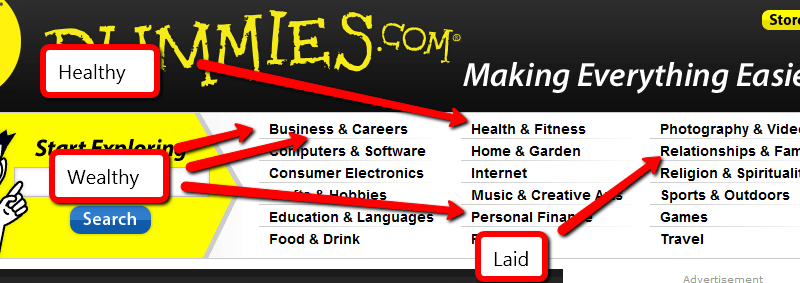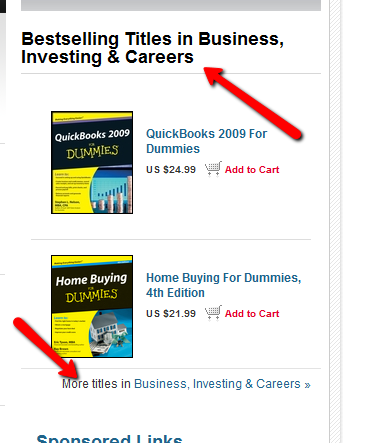This is a conversation between me and my future self, if my financial path wouldn’t have positively forked 2 years ago. The transcript is available here.
What would your future self have to say to you?
The no-pants guide to spending, saving, and thriving in the real world.
This is a conversation between me and my future self, if my financial path wouldn’t have positively forked 2 years ago. The transcript is available here.
What would your future self have to say to you?

If you want to make money, help someone get healthy, wealthy or laid.
This section was quick.
Seriously, those three topics have been making people rich since the invention of rich. Knowing that isn’t enough. If you want to make some money in the health niche, are you going to help people lose weight, add muscle, relieve stress, or reduce the symptoms of some unpleasant medical condition? Those are called “sub-niches”. (Side question: Viagra is a sub-niche of which topic?)
Still not enough.
If you’re going to offer a product to help lose weight, does it revolve around diet, exercise, or both? For medical conditions, is it a way to soothe eczema, instructions for a diabetic diet, a cure for boils, or help with acne? Those are micro-niches.
That’s where you want to be. The “make money” niche is far too broad for anyone to effectively compete. The “make money online” sub-niche is still crazy. When you get to the “make money buying and selling websites” micro-niche, you’re in a territory that leaves room for competition, without costing thousands of dollars to get involved.
Remember that: The more narrowly you define your niche market, the easier it is to compete. You can take that too far. The “lose weight by eating nothing but onions, alfalfa, and imitation caramel sauce” micro-niche is probably too narrowly defined to have a market worth pursuing. You need a micro-niche with buyers, preferably a lot of them.
Now the hard part.
How do you find a niche with a lot of potential customers? Big companies pay millions of dollars every year to do that kind of market research.
Naturally, I recommend you spend millions of dollars on market research.
No?
Here’s the part where I make this entire series worth every penny you’ve paid. Times 10.
Steal the research.
My favorite source of niche market research to steal is http://www.dummies.com/. Click the link and notice all of the wonderful niches at the top of the page. Jon Wiley & Sons, Inc. spends millions of dollars to know what topics will be good sellers. They’ve been doing this a long time. Trust their work.

You don’t have to concentrate on the topics I’ve helpfully highlighted, but they will make it easier for you. Other niches can be profitable, too.
Golf is a great example. Golfers spend money to play the game. You don’t become a golfer without having some discretionary money to spend on it. I’d recommend against consumer electronics. There is a lot of competition for anything popular, and most of that is available for free. If you choose to promote some high-end gear using your Amazon affiliate link, you’re still only looking at a 3% commission.
I like to stick to topics that people “need” an answer for, and can find that answer in ebook form, since I will be promoting a specific product.
With that in mind, pick a topic, then click one of the links to the actual titles for sale. The “best selling titles” links are a gold mine. You can jump straight to the dummies store, if you’d like.
Of the topics above, here’s how I would narrow it down:
1. Business and Careers. The bestsellers here are Quickbooks and home buying. I’m not interested in either topic, so I’ll go into “More titles”. Here, the “urgent” niches look like job hunting and dealing with horrible coworkers. I’m also going to throw “writing copy” into the list because it’s something I have a hard time with.

2. Health and Fitness. My first thought was to do a site on diabetic cooking, but the cooking niche is too competitive. Childhood obesity, detox diets and back pain remedies strike me as worth pursuing. I’m leaning towards back pain, because I have a bad back. When you’ve thrown your back out, you’ve got nothing to do but lie on the couch and look for ways to make the pain stop. That’s urgency.
3. Personal Finance. The topics that look like good bets are foreclosures and bankruptcies. These are topics that can cost thousands of dollars if you get them wrong. I hate to promote a bankruptcy, but some people are out of choices. Foreclosure defense seems like a good choice. Losing your home comes with a sense of urgency, and helping people stay in their home makes me feel good.
4. Relationships and Family. Of these topics, divorce is probably a good seller. Dating advice definitely is. I’m not going to detail either one of those niches here. Divorce is depressing and sex, while fun, isn’t a topic I’m going to get into here. I try to be family friendly, most of the time. Weddings are great topic. Brides are planning to spend money and there’s no shortage of resources to promote.
So, the niches I’ve chosen are:
I won’t be building 9 niche sites in this series. From here, I’m going to explore effective keywords/search terms and good products to support. There’s no guarantee I’ll find a good product with an affiliate program for a niche I’ve chosen that has keywords that are both highly searched and low competition, so I’m giving myself alternatives.
For those of you following along at home, take some time to find 5-10 niches you’d be willing to promote.
The important things to consider are:
1. Does it make me feel dirty to promote it?
2. Will there be customers willing to spend money on it?
3. Will those customers have an urgent need to solve a problem?
I’ve built sites that ignore #3, and they don’t perform nearly as well as those that consider it. When I do niche sites, I promote a specific product. It’s pure affiliate marketing, so customers willing to spend money are necessarily my target audience.

As parents, it is our job to teach our kids about a lot of things: driving, reading, manners, sex, ethics, and much, much more. How many of us spend the time and effort to teach our kids about money? A basic financial education would make money in early(and even late) adulthood easier to deal with. Unfortunately, money is considered taboo, even among the people we are closest to.
It’s time to shatter the taboo, at least at home. Our kids need a financial education at least as much as they need a sex education, and—properly done—both educations take place at home.
How do you know what to teach? One method is to look back at all of the things you’ve struggled with and make sure your kids know more than you did. If that won’t work, you can use this list.
Those are the lessons that I am working to instill in my children, a little at a time. Am I missing any?

Last week, my wife posted on Facebook that she was frustrated with her job hunt.

An hour later, she got a call from someone she hadn’t talked to in 10 years. He wanted to talk about a great business opportunity. He wouldn’t say what it was, but wanted to bring a friend over to discuss it.
Fast forward to last night.
The night my wife agreed to meet with the old friend.
The meeting we forgot about.
So we invited our friend and his friends into the house. We sat down at the dining room table to hear the pitch. Our friend is just getting started so his “friend” delivered the pitch.
While I was waiting for him to explain the business, he was showing us pictures of he and his wife traveling around the country.
Instead of explaining the product, he asked about our most expensive dreams.
Instead of telling us how the marketing worked, he mentioned something about utilizing the internet–and i-Commerce–and talked about changing our buying habits.
Instead of showing us a product, he talked about driving volume and building a team.
There was nothing concrete, but a lot was said to ride on the dreams of people who are frustrated with their income or are living paycheck-to-paycheck.
More than an hour into the presentation, it was revealed that the “product” is a buying portal to allow people to buy Amway products from your personal Amway store.
Freaking Amway.
How do they find your personal Amway store, you ask? I don’t know, because you are supposed to be your own best customer. You make money by buying the products you use anyway, but buy them from Amway. For example, there’s the $10 toothbrush, the $16 baby wipes, or the $38 toilet paper.
For six frickin’ rolls.
Seriously, this stuff is meant to touch my butt once. I don’t need it made from pressed gold.
As for the visual…you’re welcome!
So I sell a kidney to buy enough toilet paper to keep my nether bits clean for a month and I get one point for every $3 I spend. I figure that’s about 50 points per month, given the foot traffic our bathrooms see.
If I hit 100(I think, he didn’t leave the paperwork) points, I get 6%(again, I wasn’t taking notes) back at the end of the next month. For the sake of the math, I’m going to double the number of butts in my house. 100 points means I need to spend $300. That’s 47 rolls of toilet paper. In exchange for this $300–and on top of gold-embroidered silk I now get to flush down the toilet–I’ll earn $18.
I know exactly how much toilet paper I buy right now. Amazon sends me a 48 roll package every other month for $31.42, shipped.
To simplify, Amway is offering me the ability to spend $300 to get $18 plus $31.42 worth of toilet paper. I’m supposed to end my financial worries by turning $300 into $50 every month.
Yay!
[Note to self: Demolish Amway’s business model by starting a company that will let people turn $200 into $50, without the nasty overhead of stocking overpriced crap. A 33% increase in efficiency will make me rich!]
But wait, say the imaginary Amway proponents that I hope aren’t frequenting my site, you’re forgetting the most important part!
Oh really?
There’s also a thing called a “segmented marketing team”. To the rest of the multi-level marketing world, this is known as your downline. If you can con your family and friends into turning their $300 into $50 every month, then help them con their family and friends into turning $300 into $50 every month, you’ll get rich! Amway has apparently figured out a way to share a small fraction of their 600% markup with their victims to make them feel like it’s a business opportunity instead of a robbery.
If I get 9 people in my “business team” and each of them build out their team, I get the coveted title of “Platinum Master” or whatever. All I have to do is sell the souls of 72 people and I can make a ton of money! If each member of my downline turns $300 into $50, Amway will get $18,000. In exchange for delivering those souls, the “average” Platinum Ninja makes about $4500 per month. That’s about $12,000–free and clear–for Amway.
When your business model consists entirely of your sales force doing all of the buying and consuming, it’s not a business model, it’s cannibalism.

Pre-sale preparation and marketing are important, but ultimately, the money comes from how you manage the sale.
How many people will you have staffing the sale? There are a few considerations here. How many people are involved in the sale? How many people can take the time off? It’s best to have three people at the sale at all times. Two people can manage the money while the third plays salesman and security. Staffer #3 is in charge of watching for price-tag swaps or other theft, answering questions, and trying to upsell. It also allows for breaks, which, if you’ve ever spent a day in a garage drinking coffee, is important.
When are you going to be open? You don’t want to open so early you don’t have time to wake up and get ready for the sale, but you don’t want to open so late the professional garage-salers drive past and forget about you. Plan to open sometime between 7 and 9. When will you close? Staying open until 6 will catch most of the after-work crowd, but it makes for a long day, but closing at four cuts out a lot of the late-day shoppers. Our hours were 8-5, which seemed to be a good compromise between a long day and the best sale.
[ad name=”inlineleft”]Don’t be afraid to shut down. The first day of our sale was cold, wet, and miserable. We had to canopies in the driveway, but everything was getting wet, anyway. Traffic was slow and we weren’t enjoying ourselves, so we shut down. Lunch and a nap improved our outlook considerably. At the end of the day, we start packing up, even if people were there. We tried to only pack what they had looked at, and we didn’t try to rush the potential customers, but we did let them know that the sale was ending for the day. The folks who came in half an hour after close on the last day seemed upset that we didn’t unpack everything for their amusement.
Our layout was designed to get everything easily visible while maximizing traffic. The first day, we were confined to the garage and tents, so space was limited. There were baskets under each of the tables. That forced people to crouch and block each other. The second day, we expanded to fill the driveway. Our tables were organized in 3 rows–a “U” shape with a double-wide row of tables in the middle. This allowed people to see everything in one pass. The middle row had periodic breaks so we could move around to help the customers. The pay table was in the middle of one of the outer rows, which let us monitor the entire sale.
Find someone to watch the kids and pets. If you have to keep an eye on your children, you aren’t watching the customers or giving them the attention they need. Your dog–no matter how well-behaved–is a liability. It will be stressed at the people. Some customers will be allergic or afraid. Just don’t do it.
Ideally, you will have someone who isn’t taking money, knows a little bit about most of the merchandise, and isn’t too shy to talk to strangers. His job is to wander around, answer questions, and help people decide if they want an item. He’s the sales-weasel. If he’s pushy, he’ll chase off the customers, but if he’s hiding, he isn’t making any money. Unusual items should have a sign attached explaining why they are special, so the sales-weasel doesn’t have to explain it to everyone.
Every single item should be priced, but not everything needs to be priced individually. We priced all of the movies in a group. “VHS: $0.50 or 5 for $2, DVD $3 or 4 for $10”. Nobody should have to ask what an item costs. If there are multiple people doing a sale together, make sure everyone is using colored price tags to identify who is selling what.
People come to garage sales expecting to find good deals. If they don’t, they’ll leave. Our rule of thumb for pricing was about 25% of retail, with wiggle-room for the item’s condition. New-in-the-box sometimes made it up to 50% of retail. Our goal was primarily to reduce clutter, so a lot of items were priced at 10%. You have to keep in mind that, if you price things too low, people will assume there is something wrong with it and not assign a value in their own minds. Price it at what you would be willing to pay in a garage sale, then mark it up–just a bit–to account for haggling.
People love to haggle at garage sales. It gives them an opportunity to brag about the great deal they fought for. Try to accommodate them. One of the people participating in our sale was selling antiques with a definite value. She didn’t want to haggle on any prices, so we simply hung up a sign that read “All white-tagged prices are firm.” Everyone else was willing to accept almost any reasonable offer. Our most important rule for accepting a price? If you pissed me off, I didn’t budge on price. Insult me, or offer 1/10 of the price, and my defenses go up, bringing your final price with it. Talk nice and use some common sense while haggling, and you got what you asked for.
[ad name=”inlineright”]Could we have maximized the sale more? Probably. I had intended to hang up a sign that simply said “$100” to set a high anchor-price on everything, but I forgot.
Note: The entire series is contained in the Garage Sale Manual on the sidebar.
Update: This post has been included in the Carnival of Personal Finance.
Yes, it’s Saturday. Tomorrow, I’m hosting the Yakezie Carnival, so I bumped this up a day.
This week has been super relaxing. Wrestling season is over. We’re done with activities for a while.
Last month, I was trying to do 100 perfect push-ups in a single set. I recorded each session in a spreadsheet. I hit my goal on the 28th, 3 days early. Since then, I’ve cut down to just one session per day. I’m now doing 35 slow, deep push-ups every morning. It’s not a goal, or a challenge, just part of a general effort to be healthier.
I am on the Slow Carb Diet. At the end of the month, I’ll see what the results were and decide if it’s worth continuing. For those who don’t know, the Slow Carb Diet involves cutting out potatoes, rice, flour, sugar, and dairy in all their forms. My meals consist of 40% proteins, 30% vegetables, and 30% legumes(beans or lentils). There is no calorie counting, just some specific rules, accompanied by a timed supplement regimen and some timed exercises to manipulate my metabolism. The supplements are NOT effedrin-based diet pills, or, in fact, uppers of any kind. There is also a weekly cheat day, to cut the impulse to cheat and to avoid letting my body go into famine mode.
I’m measuring two metrics, my weight and the total inches of my waist , hips, biceps, and thighs. Between the two, I should have an accurate assessment of my progress.
Weight: I have lost 41 pounds since January 2nd. That’s 1 pound since last week and 8 pounds in March, while doing an insane amount of push-ups and packing on a few pounds of muscle. Seriously, for the last couple of weeks, on the days I haven’t totally slacked off, I’ve been doing 500+ push-ups a day. That’s a lot.
Total Inches: I have lost 23 inches in the same time frame, up 1 inch since last week. That makes me sad, but it seems to be muscle growth, so it’s not too bad.
Mint shows how lazy employees are, on average. Surprisingly, only 2.09 hours are wasted in the average 8 hour day. The rule I’d heard before is that employers expect 2-3 good, solid hours of work our of their employees every day.
Money Crasher has some cheap appetizer recipes. I can’t wait to make the biscuit meatballs.
The Mars Rover died. Tragic.
Get Rich Slowly has a post on emergency preparedness. If I mentioned that I keep enough supplies in my car to live for a week, would that make me a survivalist or just a fun guy?
LRN Timewarp
This is where I review the posts I wrote a year ago. Did you miss them then?
First, I examined the value of exchanging your time to save a bit of money.
Then, I talked about the futility of trying to force your spouse into frugality.
Filing Bankruptcy: Pride or Shame? was an Editor’s Pick in the Totally Money Blog Carnival at Debt Free Divas. Thank you!
Budgeting tips – sticking to your budget was included in the Festival of Frugality.
Saving Money: The Warranty Fund was included in the Carnival of Personal Finance.
Thank you! If I missed anyone, please let me know.
There are so many ways you can read and interact with this site.
You can subscribe by RSS and get the posts in your favorite news reader. I prefer Google Reader.
You can subscribe by email and get, not only the posts delivered to your inbox, but occasional giveaways and tidbits not available elsewhere.
You can ‘Like’ LRN on Facebook. Facebook gets more use than Google. It can’t hurt to see what you want where you want.
You can follow LRN on Twitter. This comes with some nearly-instant interaction.
You can send me an email, telling me what you liked, what you didn’t like, or what you’d like to see more(or less) of. I promise to reply to any email that isn’t purely spam.
Have a great week!